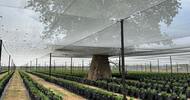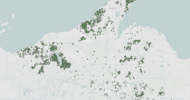Andrew Shirley
While other property markets crumbled last year, global farmland values initially kept rising. But recently that resilience has been tested. Andrew Shirley investigates whether agriculture is still a good investment
Agricultural land was the property market's darling for much of last year. A massive land rush ensued as new farmland funds touted for business and governments from cash-rich but food-poor nations scrambled to secure productive farmland to feed their populations.
One of the key drivers was a surge in soft commodity prices. World cereal stocks were dwindling and the price of biofuels produced from crops like maize (corn) and sugar cane escalated in tandem with oil prices. Eager investors piled into anything to do with farming and, of course, acquired land. In undervalued areas this helped push prices to more realistic levels, but in others it created an overheated market that has now started to cool, as recession forces down commodity prices and potential investors struggle to access credit. In some cases the bubble has burst spectacularly.
Ukraine falls into this latter category. A country with countless under-utilised hectares of fertile black Chernozem soils, it seemed ripe for investment.
In their eagerness, many investors overlooked the issue of land tenure: in Ukraine there is no legal framework for the private ownership of land – you can only buy the right to rent it. Lease agreements of between two and 20 years were being sold for up to $1,000 per hectare at the beginning of 2008. Now, following an IMF bailout of Ukraine, they are worth only $250, according to Brown & Co, a company that advises on land deals in Eastern Europe and Russia.
Soil searching
Land values in nearby countries with similar soils but more stable environments have fared better. In Russia, the primary land market consists of small blocks of land distributed to individuals following the fall of communism. This has remained stable, at about $300 per hectare, but large consolidated blocks have fallen by about 20% to $800 per hectare.
In countries where demand is also supported by indigenous farm businesses, there has been less of a slowdown. Within the EU, agricultural subsidy payments also help to level the market. In Poland, for example, arable land values have fallen since peaking last summer, but still ended 2008 at about 20,000 zlotys per hectare (€4,800), about 10% more than they were at the beginning of the year.
New EU members, such as Romania, appeal to investors because they offer the prospect of an increase in capital values as land prices, bolstered by subsidies and access to EU markets, gradually catch up with those in countries such as the UK.
Investing is not without risk, however. Agricultural infrastructure lags behind Western Europe and land tenure, while legally binding, is less transparent. Much of the land remains in small post-communist parcels. In Romania, values stayed at about €3,500 per hectare during 2008, but are likely to weaken as potential investors struggle to access funds this year.
Currency considerations
When looking at potential investments, shifts in exchange rates make it important to not just consider changes in home currency values. Despite falling in value in the final quarter of 2008, English farmland increased by 16% overall to almost £12,000 per hectare, according to the Knight Frank Farmland Index. But sterling’s slide against the dollar and euro means land at the beginning of this year was 16% cheaper for US buyers and 11% down for those from the eurozone.
Brazil is another country where fluctuations are working in favour of outside investors. One US dollar bought 1.5 reais last August; now it will buy about 2.3. In reais, average values rose by 8% last year to R$4,330 per hectare ($1,850), according to the AgraFNP land price survey. But land used to grow sugar cane has been badly hit by falling ethanol values and prices in some areas are said to have fallen by up to 50%. South America offers vast swathes of cheap, undeveloped land that can be converted into valuable cropping or pasture land and sold on for big profits. In Brazil it is still possible to buy 100,000 hectares of undeveloped land in a single block. Prices vary, but can be as low as $200 per hectare.
US land values are linked to farm profitability and have been rising strongly. The US Department of Agriculture estimates farm incomes reached almost $90bn last year, 42% above the 10-year average. Much of this was fuelled by a rash of new maize-hungry bio-ethanol refineries. Farmland values in the Midwestern breadbasket states rose rapidly as a result, with prices in Iowa up 14% to $11,000 per hectare. Further rises now seem unlikely, as falling ethanol prices threaten the viability of refineries.
While the credit crunch has affected demand for land in most parts of the world, Australia and Canada actually seem to be benefiting. The combination of relatively cheap land and a low-risk political and economic environment is attracting investors who might otherwise have considered South America or Eastern Europe. In the Canadian prairie states, average values rose 10% in 2008 to C$2,100 per hectare ($1,725), says fund manager Agcapita, while in Australia, productive cereal land rose 10% to A$4,950 per hectare ($3,450).
Long-term outlook
For the far-sighted investor, an agricultural downturn could be the ideal time to buy farmland. Most commodity analysts believe the current situation is a dip in a longer upwards trend driven by factors such as an increasing world population and a slowdown in agricultural productivity gains.
Deciding where to invest depends on your aversion to risk – some areas with the highest potential returns also offer the biggest challenges, particularly where the politics of food production are contentious.
Rich nations with limited agricultural resources have already been accused of neo-colonialism as they try to secure land in some of the world’s poorest countries. Escalating food prices prompted riots across the developing world last year, and foreign ownership of land may not sit well with poor populations struggling to feed themselves.
Andrew Shirley is Head of Rural Property Research at Knight Frank.













